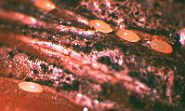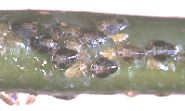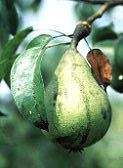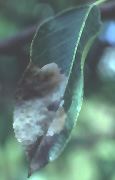Hello, everyone,
At this week's orchard meeting in Albemarle County, there was quite a bit of discussion on pear psylla. With recent increases in pear acreage in the state, there is more interest in pear psylla, a key pest of pear throughout North America (originally introduced from Europe, along with pear - there are no native American pear species). I am inserting below the pear psylla material from the Virginia Fruit web site - watch for updates as we adjust our management recommendations. A key point to note now is the appearance of the eggs. Eggs are laid in spring by the overwintered adults, especially in the crevices at the base of fruit spurs. These are light in color at first, later turning a light orange color.Pear Psylla, Cacopsylla pyricola (Foerster)
I. Introduction: Pear psylla (PP) is the most important insect pest of pear in all pear-growing regions (Asian pear species are less susceptible). It is responsible in large part (along with fire blight) for the decline of cultivation of pear in the eastern states. It is the only one of several European pear psyllids to have been introduced into North America. It was first introduced into Connecticut around 1832, and reached Virginia (Charlottesville) by 1894. II. Hosts: PP develops only on pear.III. Description: Summer form: The length of adults to the tip of folded wings is about 8/100 - 11/100 inch (2.0-2.75 mm). The color is light orange to red brown, with darker markings (four stripes along the back). The legs and antennae are mostly light brown to orange. Wings are clear with a conspicuous black spot on the hind edge (at the midline when at rest). Winter form: The length of adults to the tip of folded wings is 13/100 - 16/100 inch (3.3-4 mm). The body color is now very dark red-brown to black (Plate 87). The wing veins are very dark and conspicuous, and the wing spot is now more pronounced. In both forms, the head is a little over half as long as wide. The antennae are 1 1/2 times as long as width of head.
Eggs are pale cream to yellow-orange. They are elliptical in shape, with a tiny peg inserted into plant tissue. Nymphs are pale yellow when young, but have brown sclerotized plates when older. They resemble flat aphids in shape.


IV. Biology: Adults overwinter in or near pear orchards. Few adults are mated before overwintering. In early spring adults return to the trees, mate and begin ovipositing in crevices on fruit spurs and on young leaves as they unfold. There are three generations during the spring and summer. In the fall, when daylength falls below 13.5 hours, an overwintering form is produced which is darker than the summer adult. There is some degree of reduced fecundity in crosses between these forms.
Females lay an average of more than 300 eggs during their life. Most oviposition by summer adults occurs near leaf midveins; egg survival is also highest near midveins. As nymphs develop, they become engulfed in a droplet of accumulating honeydew. Such droplets may contain the shed skins of the preceding instars.
Recent research at USDA indicates that a transgenic pear line (developed for resistance to fire blight) may be less suitable as a host for pear psylla.
V. Injury: Although it is classed here as an indirect pest because it feeds on leaves, the main source of economic injury is to the fruit. Honeydew supports growth of sooty mold and causes a black russet on fruit; necrotic areas on foliage may also develop. PP serves as the vector for the mycoplasma-like organism causing pear decline when European scions are grown on Asian rootstocks. The latter problem is avoided by choice of rootstock/scion combination. Sooty mold and leaf injury may reduce photosynthesis and return bloom.


VI. Monitoring: PP may be monitored in several ways. In the spring, examine growth scars on spurs and twigs for the appearance of the first eggs. This method is used to time the delayed dormant application. Adults may be monitored by a beating tray method or with yellow sticky traps. A beating tray size of 18x18 inches (45x45 cm) was used in Connecticut; the tray is held beneath a limb and the limb is jarred three times in succession, sampling four limbs on each of 10 trees per block. Adults are counted on the surface of the tray.
Action should be taken when the first eggs laid in the spring appear. Research in Washington State has found that a peak density of 0.3 nymphs/leaf causes detectable fruit injury on both `Anjou' and `Bartlett'. Populations causing 9 and 18 nymph-days per leaf caused injury on the two varieties, respectively, with no significant effect of period during the season. Averages of 1.0-1.2 adults per beating tray or 4.4-6.9 adults per sticky trap were recommended as action thresholds by Connecticut researchers.
VII. Control: Dormant oil may be applied when eggs begin to appear in spring (see photo above). Various insectides are registered for post bloom control. Horticultural spray oil may be applied. This is more highly refined than dormant oil and should not be confused. Also, a lower rate is used, 1 qt/100 gal, rather than the 2 gal / 100 gal recommended in dormant sprays. Horticultural spray oil is recommended to be included with avermectin sprays.
No comments:
Post a Comment